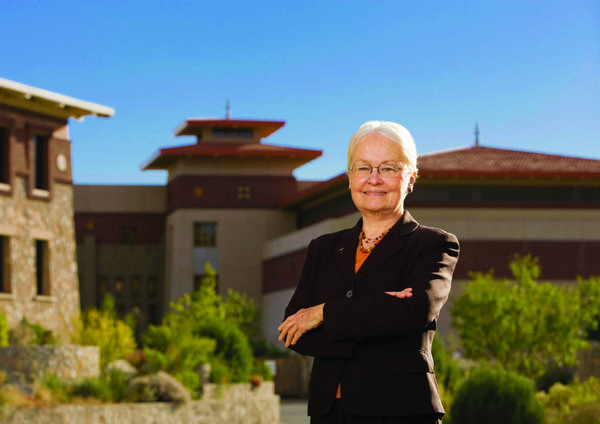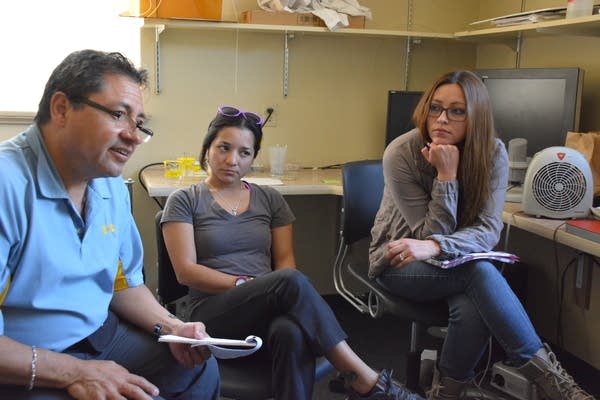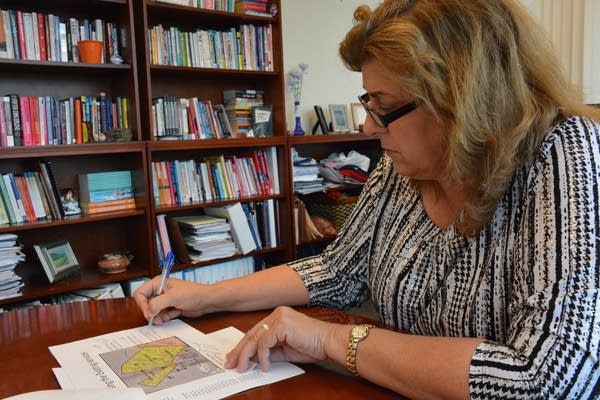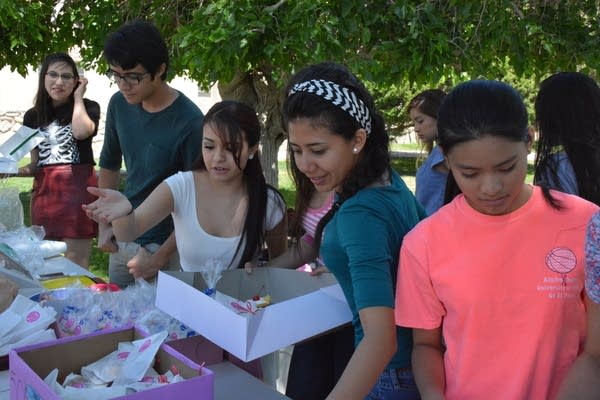University of Texas at El Paso: Opportunity U.
University of Texas at El Paso President Diana Natalicio has a problem with the "nontraditional student." She doesn't like the term. "It suggests that you're not something, rather than that you are something new," she says.

University of Texas at El Paso President Diana Natalicio has a problem with the “nontraditional student.” She doesn’t like the term. “It suggests that you’re not something, rather than that you are something new,” she says.
She prefers to call the mostly Hispanic, mostly low-income students at UTEP “21st century” students. She sees them as pioneers in higher education, and her goal is to make them full participants in the 21st century global economy.
Natalicio was a first-generation college student herself. She’s convinced there’s untapped talent in communities like the one she grew up in, and she doesn’t want to squander it. She cites data that show less than 10 percent of students from low-income families get four-year degrees, compared with about 75 percent of those from upper-income families.
“Shame on us,” she says. “Because talent and wealth are not correlated. They’re not. Because talent crosses all boundaries and it is appalling to think there would be that big a gap, and that gap has grown over the last 40 years.”
Since she became president in 1988, Natalicio has steered UTEP toward helping low-income Hispanic students succeed. She wants the university to be part of a national movement to remake colleges and universities to serve the students of the future.
“The demographics of the entire United States, certainly the state of Texas are changing dramatically,” Natalicio says. “We were at the forefront because we happen to be located where we are. And so it’s very exciting that we develop programs to share with others: success stories in how you work with a population that has been historically underserved.”
‘A Model Urban University’

El Paso is in far west Texas, just across the Rio Grande from Juarez, Mexico, and about 40 miles from Las Cruces, New Mexico. The area’s population is about 3 million.
It’s “a population that historically didn’t have higher education opportunities,” Natalicio says.
Natalicio came to the university in 1971 as a Portuguese professor. A native of St. Louis, she says she didn’t think she would build a career in El Paso. But she enjoyed spending time in Mexico, back when it was easy to cross the border. She said hiking in the desert was exhilarating.
“I loved it here,” she says. She decided to apply for tenure. “I felt this university could have a powerful impact on this region.”

Natalicio became chair of the modern language department, then dean of the College of Liberal Arts. She was named interim president in 1987. When she became president the following year, she assembled a team to help her harness the “untapped talent” of the region.
The city had been growing in population, but not in prosperity through the ’70s and ’80s. It attracted industries that used low-skilled, low-wage labor.
Steve Riter, vice president for information resources and planning, says the city’s demographics were changing.
“I’m not sure there was white flight as much as all the growth was in the Hispanic community,” Riter says. He says the team wanted to create a “model urban university,” and thought, “A modern urban university ought to look like the city it services.”
Those early leaders shared a notion that UTEP had an identity problem. It had aspired to be something it wasn’t. Riter remembers “Harvard on the Border” bumper stickers from that era, and UTEPs aspiration to become an elite university in the world of higher education.
“We said, ‘No, that’s not right. We know who we are, we know who we want to be,'” Riter says.
He says UTEP should not have been trying so hard to attract students from faraway places.
“To think that we’d draw people out of the clear blue from all over the country to some obscure place off the beaten track was just nuts,” he says.
The new leaders wanted UTEP to become the region’s university, to enroll the low-income Hispanic kids whose parents had not necessarily gone to college, or even finished high school.
“I hate to talk about it in business marketing terms, but that market was only going to grow,” Riter says. “And if we didn’t find a way to be welcoming to people who might not have felt so welcomed, we wouldn’t have anybody to be a student.”
Riter says reaching out to the community was the right thing to do, but it also made economic sense.
“It’s not bleeding-heart liberalism, it’s just self-interest,” he says. “We had a population here who had not participated in higher education to the extent that we would have liked, and so we had to find ways to reach out to them.”
Some of the first steps were simple. UTEP was a commuter campus, but there weren’t many places on campus to gather and study. It didn’t recruit from local high schools. It didn’t host many community events. That all changed the first few years of Natalicio’s tenure.
UTEP Then and Now

Eddie Castañeda was an undergraduate at UTEP 1974-1978, the first in his immediate family to go to college.
He majored in psychology, and developed a special interest in brain chemistry.
He got his master’s degree at UTEP too, in the days when Hispanics were still a minority on campus. He wanted to become a researcher. He knew a doctoral degree would give him more opportunity, but he wasn’t sure he could get one.
“I didn’t think I was going to get into graduate school even with a master’s degree,” he says.
He decided to shoot for the moon, and apply to six schools. He says that’s all he could afford. He was amazed when he was accepted at all six.
“Now, there’s no better demonstration than that to indicate something called implicit bias and the messages that tell us we’re not good enough,” he says. “Somebody taught me something and I bought it and it wasn’t true.”

Now, as a professor, he says he’s determined to raise his students’ expectations for what’s possible.
One of his students is Tania Moreno.
Like many UTEP students, Moreno spent most of her childhood in Mexico. Her parents moved to El Paso when she was 14, so that’s when she learned English.
“In high school, they basically just put you in classes,” Moreno says. “They’re all in English so you’re forced into speaking the language.”
Moreno’s mother stayed home and her dad drove a truck. They urged her to go to college.
“I’m not saying where they are is bad, but they didn’t want me to end up in the same spot,” Moreno says. “They wanted me to go a little further. They never went to college so they didn’t know what it was going to be like.”
Moreno’s parents couldn’t help her pick a major, so she decided on her own what to study. Now she is a junior majoring in psychology, with a minor in chemistry. Like Professor Castañeda, she is interested in neurotransmitters. She plans to get her master’s degree at UTEP and then go to the University of Michigan for a Ph.D, like he did.
Castañeda sold shoes in a Kmart to support himself through college. For her first two years, Moreno was an office assistant for a chiropractor. But then she got a job in Castañeda’s research lab, where undergraduates work together with graduate students on rat brain experiments. They’re trying to understand what happens to neurotransmitters in patients with Parkinson’s Disease.

Providing research positions to undergraduates is an important part of the UTEP plan.
“The research that undergraduates get to do is beneficial in many ways,” says Donna Ekal, associate provost for undergraduate studies. First of all, it’s a paid job, one that deepens students’ connection to campus.
It also “gives them an opportunity to do something they haven’t been exposed to before,” Ekal says. “Connections to career pathways they never thought possible.”
The provost’s office houses many programs that offer outreach and support to students who may face obstacles at college.
It runs an entering-students program that pairs newcomers with peer and faculty mentors.
It works closely with El Paso Community College on transferring credits easily between the two institutions.
It oversees a robust paid-internship program that matches undergraduates with multinational companies like Exxon-Mobil, Boeing and Google.
Ekal says the study-abroad program is a good example of UTEP innovations. Ekal wanted UTEP students to have the opportunity to go abroad like many students at elite universities do. But she knew that wasn’t realistic.

“They can’t take that semester or year off like a traditional study abroad student would because they’d have to quit their job, or they wouldn’t be able to help their family out in ways they do,” she says.
So Ekal’s team came up with ways to shorten the trip. Faculty members take students on two-week trips in conjunction with a class. That way, they don’t lose financial aid and they benefit from group discounts. Plus, Ekal says, “Students doesn’t have to quit job because it’s only two weeks, and it’s not nearly as expensive because it’s only two weeks.”
She also works closely with other public universities on access issues. For example, she’s piloting a project to make credits more transferrable among schools for members of the military who are frequently transferred between bases.
Access AND Excellence
UTEP admits nearly everyone who applies. That’s the accessible part of its mission. Administrators say the other part of its mission — excellence — is just as important.
“There’s a lot of people who say you can’t do it, you can’t have access and excellence,” says Gary Edens, Vice President for Student Affairs. He says having both is a tricky balancing act. But he calls it a healthy tension that keeps administrators motivated.
“Because letting [students] come to your university and not making sure that they can compete after they graduate is meaningless,” Edens says. “So the measure of excellence for me is our alumni who go out there and do amazing things in the community.”
Edens says UTEP graduates are admitted to top professional and graduate schools. A 2010 survey showed 94 percent of its recent graduates are employed full time, and 43 percent had enrolled in graduate school since earning their degree.

Washington Monthly ranked UTEP in the top ten in overall quality among national universities, along with Harvard and Stanford.
A component of that ranking is a school’s ability to attract research dollars. During President Natalicio’s tenure, annual research spending has risen from $6 million to more than $84 million. The school now offers 20 doctoral degrees, up from one, in geology.
UTEP tops Washington Monthly’s list in social mobility. The magazine came up with this category to rank schools on how well they serve low-income students. Data show low-income students are less likely than their more affluent peers to graduate college. The social mobility ranking measures schools’ ability to both keep costs low and help students graduate.
Administrators say as long as there is vision and leadership, the lessons learned at UTEP are replicable.
“The core of what we have done is look at our community and see who is our community, what do they need, and how do we respond to that,” says Donna Ekal, associate provost. “That’s something that is certainly transferrable.”
UTEP administrators say it’s important for colleges to collaborate and share ideas for serving the “21st century student,” because demographic changes mean that eventually all colleges will be in the situation UTEP was in: They’ll need to educate those students, or have no students at all.
“These are the people that are going to run our country for a hundred years,” says Riter. “This is all we have, and unless we want to go to a dual-class system, I think we’ve got to find a way to educate these kids.”

